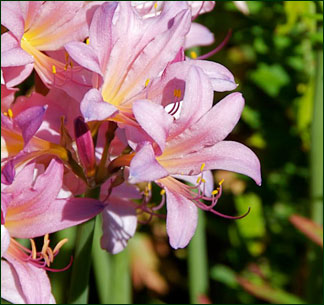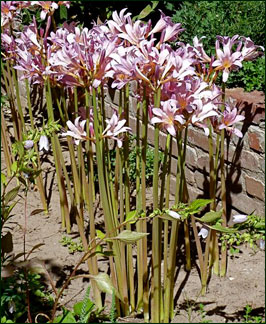Scientific name: Lycoris squamigera
Common names: Resurrection lily (also known as Magic lily)
Family: Amayllidaceae – Amaryllis
Text and Photos by Janice Tucker
 The Resurrection lily (also known as Magic lily) bulbs will be one of the most striking of the blooming plants to be offered at Santa Fe Botanical Garden’s Fabulous Fall Plant Sale on Saturday, September 4, 2010. These bulbs are from the beautiful garden of Jan Barbo, who brought them from her mother’s home in Arkansas. Jan has proven that the Resurrection lily does very well in northern New Mexico.
The Resurrection lily (also known as Magic lily) bulbs will be one of the most striking of the blooming plants to be offered at Santa Fe Botanical Garden’s Fabulous Fall Plant Sale on Saturday, September 4, 2010. These bulbs are from the beautiful garden of Jan Barbo, who brought them from her mother’s home in Arkansas. Jan has proven that the Resurrection lily does very well in northern New Mexico.
Actually an Amaryllis and not a Lily, the Resurrection lily is a late summer bloomer. Narrow, foot long, strap-like, grayish-green leaves emerge in spring and then die back in early summer. Wait. Don’t despair. The plant isn’t anywhere near dead. It’s just playing possum. The real show is about to begin and the reason for the name “Resurrection” or “Magic” will soon be revealed. Seemingly rising from the dead, thick naked flower scapes spring up where the leaves died back, reaching a height of two-plus feet, bearing between four and seven fragrant, funnel-shaped rosy pink flowers with a touch of lavender lining the petal edges and tips.
The Resurrection lily is often mistaken for similar flowers such as the Amaryllis belladonna or the Colchium spp., (a member of the Colchicacea family), both of which are often called Naked Lady because of the leafless stalks. Some sources also refer to the Resurrection lily as the Naked Lady, or as one nursery dubbed it, “Nekkid Ladies.” Alas, common plant names often have no family loyalty. The genus Lycoris is named after the Roman actress and mistress of Mark Antony, adding a bit of intrigue to the plant’s charm. Squamigera means “bearing scales” referring to the small scales on the flowers, which give petals their iridescent sparkle.
 When grown in clusters, the Resurrection lily is a showstopper. Some garden resources recommend planting in a flowerbed with other plants in order to hide the unadorned stalks. They do indeed get along well with other plants. But, they are also quite dramatic when seen growing in their entirety – bare stalks and all – without accompaniment.
When grown in clusters, the Resurrection lily is a showstopper. Some garden resources recommend planting in a flowerbed with other plants in order to hide the unadorned stalks. They do indeed get along well with other plants. But, they are also quite dramatic when seen growing in their entirety – bare stalks and all – without accompaniment.
A native of Japan, the Resurrection lily does very well in U.S. zones 5 to 9 and is the most cold hardy of the Lycoris species. It prefers sun but will also do well in light shade. Bulbs can be planted in a variety of well-drained soils five to six inches deep, spacing about six inches apart. Plant the bulbs in the fall and mulch in the winter. Once planted, be careful about disturbing them. They prefer to remain in their original spot. Moderate water is needed during the summer after the leaves die back before the flower stems emerge. The plant will naturalize by bulb offsets. Sometimes after the initial planting the Resurrection lily will skip a season before showing signs of life. Be patient. It will be worth the wait.
The Resurrection lily is long-lived, deer resistant and has no known serious insect or disease problems. It is also an excellent cut flower, which just gives it one more positive feature.
Be sure to add the Resurrection lily to your plant shopping list. It will bring many years of pleasure and plenty of compliments on your garden.


